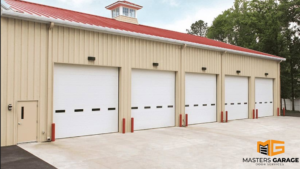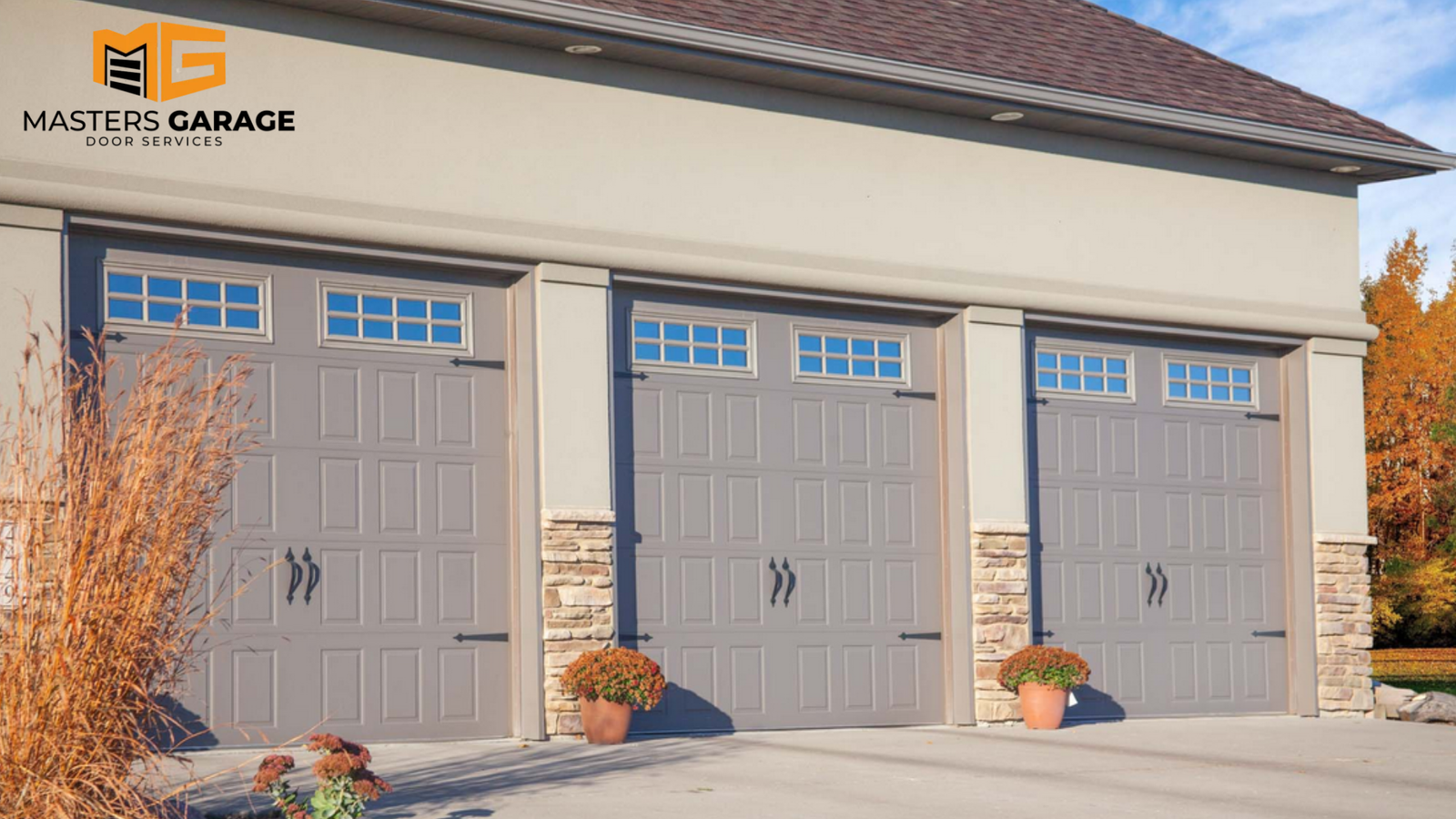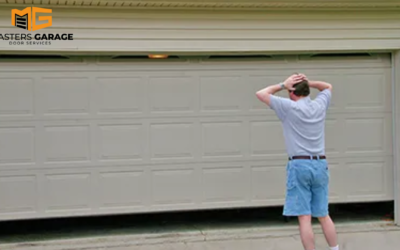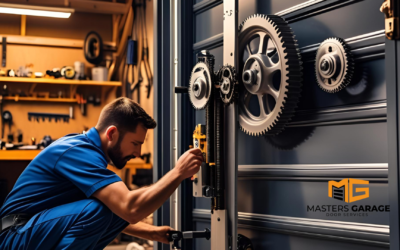1. Introduction
Garage doors are an essential part of any property, whether residential or commercial. They serve as the primary entry and exit point for vehicles and equipment while playing a crucial role in ensuring safety, security, insulation, and convenience. A well-chosen garage door not only enhances the visual appeal of a building but also contributes to energy efficiency, property value, and daily operational efficiency.
Although commercial and residential garage doors serve the same fundamental purpose of providing access and security, they are significantly different in terms of design, construction, materials, functionality, and usage frequency. These differences are driven by the unique requirements of each setting. For example, a home garage door may only open a few times a day and focus on aesthetics, while a commercial garage door might operate dozens or even hundreds of times daily and must be built to withstand heavy-duty usage.
Understanding these key distinctions is vital if you are planning to install a new garage door or replace an existing one. Choosing the wrong type of door can result in frequent breakdowns, higher maintenance costs, safety hazards, and non-compliance with local codes. On the other hand, selecting the right garage door based on the intended use, size requirements, security needs, and energy efficiency goals can save money, improve workflow, and enhance curb appeal.
This article provides a comprehensive comparison between commercial and residential garage doors. By the end, you will have a clear understanding of their core differences, enabling you to make an informed decision that suits your specific needs and property type.
2. What Is the Difference Between Commercial and Residential Garage Doors?
Residential garage doors are typically found in homes and are designed for aesthetics, moderate daily use, and compatibility with home design elements.
On the other hand, commercial garage doors are built for functionality, strength, and high-frequency operation, often seen in warehouses, delivery bays, fire stations, and industrial settings.
3. Key Differences at a Glance
3.1 Size and Dimensions
One of the most noticeable differences between commercial and residential garage doors lies in their size and dimension requirements.
Residential garage doors are generally built to accommodate personal vehicles and typical household storage needs. Standard residential door sizes range from 7 to 8 feet in height and 8 to 16 feet in width, suitable for one or two-car garages. These doors are often pre-fabricated and come in limited size options, making them easy to install and replace.
Commercial garage doors, by contrast, are often custom-sized to fit the specific needs of the facility. It’s common to find commercial doors that exceed 24 feet in width and reach heights up to 32 feet or more, especially in settings like warehouses, shipping centers, and fire stations. These larger dimensions are essential to accommodate industrial vehicles, delivery trucks, forklifts, or specialized equipment.
Additionally, clearance and headroom requirements are significantly higher in commercial environments. Facilities often require more overhead space for larger door mechanisms, high-lift tracks, and frequent vertical movement.
3.2 Materials and Build Quality
The materials used in garage doors play a vital role in their durability, weight, weather resistance, and overall lifespan.
Residential garage doors are typically constructed using a mix of wood, aluminum, fiberglass, and light-gauge steel. These materials provide a good balance between visual appeal, lightweight operation, and moderate durability, which is adequate for home use.
On the other hand, commercial garage doors are built to endure high usage frequency and harsh working environments. They are made from heavy-gauge steel, galvanized aluminum, or reinforced composite materials designed to withstand impact, wind load, and temperature fluctuations. Many commercial doors are also rated for fire-resistance and corrosion resistance, especially in chemical plants or coastal industrial zones.
3.3 Design and Aesthetics
Aesthetics is a key consideration for residential garage doors, while commercial doors prioritize functionality.
Homeowners often choose garage doors that complement the architectural design of their property. Options such as carriage-style panels, decorative windows, custom colors, and textured finishes are popular for boosting curb appeal. These doors can significantly enhance the resale value of a home and often reflect personal style.
Commercial garage doors, however, are designed with practicality and performance in mind. They usually feature a minimalist industrial design and are often plain in appearance. Since they are installed in back-of-building areas or loading docks, aesthetic customization is usually limited or unnecessary.
3.4 Hardware and Components
The internal components of a garage door system influence its performance, longevity, and safety.
Residential garage door hardware includes standard tracks, rollers, torsion or extension springs, and hinges rated for light to moderate use. These components are designed to handle a few cycles per day, typically around 3 to 5 open-close operations.
Commercial-grade components are much more heavy-duty. They are built to support high-cycle applications, often operating tens of thousands of times over their lifespan. This includes reinforced tracks, larger torsion springs, durable steel rollers, and high-tension counterbalance systems. These systems are built to reduce downtime and ensure consistent performance under demanding conditions.
3.5 Opener System and Mechanism
Garage door openers are another critical difference between commercial and residential systems.
Residential openers are generally quieter, smaller, and packed with convenience features such as Wi-Fi connectivity, smartphone controls, motion-sensor lighting, and battery backup. These openers are perfect for daily household use and are designed with home automation integration in mind.
Commercial openers are designed for power and performance. They often include gear-driven motors, chain or jackshaft operators, and are compatible with security access systems like keypads, proximity card readers, and manual override controls. These openers are expected to lift heavier doors multiple times a day with minimal maintenance.
3.6 Insulation and Energy Efficiency
Energy efficiency is a growing concern for both homeowners and business owners, especially in climate-sensitive regions.
Residential garage doors often include polyurethane or polystyrene insulation with a focus on improving comfort and reducing heating and cooling costs. A high R-value rating means better thermal insulation, which helps regulate indoor temperature and protect items stored in the garage.
For commercial buildings, insulation plays an important role in maintaining interior climate control, especially for businesses that store temperature-sensitive goods or operate in refrigerated environments. Insulated commercial doors not only help reduce energy bills but also contribute to a safer and more productive work environment.
3.7 Safety and Security Features
Safety and security features are tailored to the environment and user base of the garage door.
Residential doors include automatic reversal systems, infrared photo-eye sensors, and smart locking mechanisms to ensure family safety. Many models integrate with home security systems and offer real-time alerts through connected apps.
Commercial garage doors come with more robust safety features, including manual release levers, emergency stop buttons, tamper-proof locks, and fire-rated protections. These are often required to comply with OSHA regulations and NFPA fire codes. For high-security facilities, doors may also include roll-down security shutters, reinforced lock bars, or bullet-resistant panels.
3.8 Code Compliance and Regulations
Both types of garage doors must comply with various building codes and legal requirements, but the standards differ significantly.
Commercial garage doors must meet strict compliance standards, such as fire resistance, wind load ratings, structural integrity, accessibility codes, and emergency egress requirements. These are enforced by authorities like OSHA (Occupational Safety and Health Administration) and local fire departments.
Residential garage doors, while less regulated, still need to comply with local building codes, zoning laws, and, in some cases, Homeowners Association (HOA) guidelines. These regulations may dictate door color, design, noise levels, and even permitted access times.
4. Cost Comparison: Installation, Maintenance, and Repairs
Installation Costs
The installation cost is one of the first differences buyers notice when comparing commercial and residential garage doors.
Residential garage doors are typically more affordable to install due to their standardized sizes, lightweight materials, and simpler hardware systems. Since these doors are often pre-fabricated and installed in one- or two-car garages, the process is more streamlined. Home installations usually require fewer structural modifications and can often be completed in a single day.
In contrast, commercial garage door installations are more complex. These doors often need custom sizing, industrial-grade components, and heavy-duty motors. Installation may also require reinforced framing, overhead clearance adjustments, and integration with building automation systems or security networks. This increases both the labor cost and material expense, making commercial installations significantly more expensive.
Maintenance Requirements
Residential garage doors require maintenance once or twice a year, such as lubricating moving parts, inspecting weather seals, and testing safety sensors. The usage is usually limited to a few cycles per day, which reduces wear and tear.
However, commercial garage doors are subject to intensive daily use, often operating dozens or even hundreds of times. As a result, they require frequent maintenance to ensure continuous performance and avoid operational downtime. Preventive maintenance includes spring tension adjustments, motor inspections, track alignment, and cycle testing. Ignoring maintenance can lead to costly repairs or even temporary facility shutdowns.
Repair Complexity and Costs
When it comes to repairs, residential garage doors are generally easier and cheaper to fix. Most parts are readily available, and the systems are less complex. Common repairs include spring replacement, sensor recalibration, or panel repair.
Commercial garage door repairs, on the other hand, are often more technical and time-consuming. These systems may involve high-cycle torsion springs, heavy-duty gear drives, or integrated access controls. Malfunctions in a commercial setting can affect productivity, logistics, or safety compliance. For this reason, prompt professional repair is crucial, and costs are typically higher due to larger parts, specialized labor, and potential downtime.
5. Lifespan and Usage Frequency
Residential Garage Doors
With regular maintenance and moderate daily use, residential garage doors can last between 15 to 30 years. Longevity depends on factors such as material, climate, usage patterns, and maintenance habits. The average home garage door completes 3 to 5 cycles per day, which results in lower mechanical stress over time.
Commercial Garage Doors
Commercial garage doors are engineered for high-cycle operation and often use reinforced parts, yet their actual lifespan may be shorter due to the intensity of use. In many commercial environments, doors complete 50 to 100+ cycles per day, leading to faster wear of springs, tracks, and motors.
Most commercial systems are rated by cycle count, which is the number of open-close operations before a component is expected to fail. A standard torsion spring might be rated for 10,000 cycles, while high-cycle versions can go up to 50,000 or even 100,000 cycles depending on the application.
Understanding your door’s cycle rating and tracking usage frequency is critical in commercial settings to avoid unexpected downtime and maintain operational efficiency.

6. Types of Commercial Garage Doors
There are various types of commercial garage doors available to meet specific industry needs. Each type offers distinct advantages in terms of speed, security, space efficiency, or compliance.
Sectional Steel Doors
These doors consist of horizontal steel panels connected by hinges and roll up vertically on tracks. They are a popular choice for warehouses and distribution centers due to their excellent insulation, durability, and security. Sectional steel doors can also be equipped with windows, weather seals, and wind-load reinforcements for added performance.
Rolling Steel Doors
Also known as roll-up doors, these are constructed from interlocking metal slats that coil into a drum above the opening. They are ideal for high-traffic facilities like parking garages, auto shops, and industrial storage units. Their space-saving design allows them to be used where overhead room is limited, and they are known for being low-maintenance and high-security.
High-Speed Doors
As the name implies, high-speed doors open and close at accelerated rates, which helps maintain climate control, product containment, and workflow speed. They are commonly used in cold storage, pharmaceutical, and food processing environments where maintaining temperature and cleanliness is essential. These doors reduce air exchange and energy loss significantly.
Fire-Rated Doors
Fire-rated commercial garage doors are designed to close automatically in the event of a fire, helping to contain flames and smoke. They are built from fire-resistant steel and tested to comply with NFPA standards. These doors are vital in chemical plants, manufacturing facilities, and multi-use buildings that require fire code compliance.
Security Grilles
These are open-style roll-up grilles typically used in retail environments, malls, and public garages where visibility and airflow are desired alongside property protection. Security grilles are made from steel or aluminum and often installed behind glass storefronts or in shared access corridors to secure the premises after business hours.
7. Choosing the Right Garage Door for Your Needs
Selecting the ideal garage door requires more than just measuring the opening or choosing a style you like. It involves a careful evaluation of functionality, operational demands, energy efficiency, and regulatory requirements. Whether you’re a homeowner or a facility manager, making an informed decision ensures long-term satisfaction, performance, and value.
Key Questions to Ask:
- How frequently will the door be used each day?
If your door will operate more than a few times daily, you need a high-cycle system with durable springs and reinforced components, especially in a commercial or industrial setting.
- Do you prioritize aesthetic appeal or functional performance?
Homeowners may prefer decorative panels, custom colors, and window inserts, while business owners often need doors that are minimalist, secure, and built to last under pressure.
- Is insulation important for your property?
In areas with extreme temperatures or energy-efficiency goals, selecting a garage door with a high R-value is essential. Insulated garage doors help regulate indoor climate and reduce utility costs, whether in a residential garage or a temperature-sensitive commercial warehouse.
- Are there any building codes or zoning rules to follow?
Many commercial doors must meet fire safety, wind-load, and accessibility standards. Residential properties may be subject to Homeowners Association (HOA) regulations or local building codes that influence design, color, or noise levels.
Professional Recommendation:
No two properties are exactly alike. That’s why we always advise conducting a professional garage door consultation and on-site evaluation. An experienced technician can assess your space, usage needs, insulation goals, and compliance requirements to recommend the best garage door solution for your home or business.
Need help choosing the right garage door? Contact our garage door specialists today for a free consultation and get expert guidance customized to your specific needs.
Frequently Asked Questions
FAQ 1: What is the main difference between commercial and residential garage doors?
Answer:
The primary difference lies in design, durability, and usage purpose. Residential garage doors are typically used for homes and are designed for aesthetic appeal and moderate daily use. Commercial garage doors are built with heavier materials, industrial-grade hardware, and high-cycle operation in mind, making them ideal for warehouses, loading docks, and commercial facilities.
FAQ 2: Are commercial garage doors more expensive than residential ones?
Answer:
Yes, commercial garage doors are generally more expensive due to their custom sizing, heavy-duty materials, complex hardware, and special installation requirements. They also often require more frequent maintenance and higher repair costs compared to residential doors.
FAQ 3: Can I use a commercial garage door for a residential property?
Answer:
Technically, you can install a commercial garage door at a residential property, especially if you need extra security or larger access clearance. However, they may not match the home’s aesthetic, may be louder, and may not comply with some local residential codes or HOA guidelines. Always consult a professional before making this decision.
FAQ 4: How long do commercial and residential garage doors typically last?
Answer:
Residential garage doors can last 15 to 30 years with proper maintenance. Commercial garage doors, while made from stronger materials, may have a shorter lifespan due to intensive daily usage, typically lasting 10 to 20 years, depending on their cycle rating, maintenance routine, and operating environment.
FAQ 5: Do commercial garage doors require insulation like residential ones?
Answer:
Yes, insulation is important for both, but for different reasons. Residential doors use insulation for indoor comfort and energy savings, while commercial doors may require insulation to maintain controlled environments, protect equipment, or meet industry regulations in cold storage, food handling, or pharmaceutical facilities.




